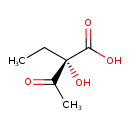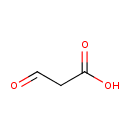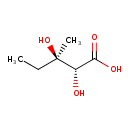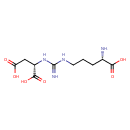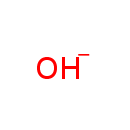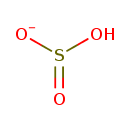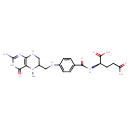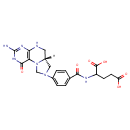
Search Results for compounds
Searching compounds for
returned 4373 results.
Displaying compounds 3721 - 3730 of
4373 in total
(S)-2-aceto-2-hydroxybutanoate (PAMDB110826)
IUPAC:
(2S)-2-ethyl-2-hydroxy-3-oxobutanoate
CAS: Not Available
Description: (S)-2-Aceto-2-hydroxybutanoic acid is an intermediate in branched chain amino acid metabolism. It is converted from 2-oxobutanoate or 2-hydoxyethyl ThPP via acetolactate synthase.
3-oxopropanoate (PAMDB110827)
IUPAC:
3-oxopropanoate
CAS: 926-61-4
Description: Malonic semialdehyde is formed in the alternative pathway of propionate metabolism and in the catabolism of beta-alanine. Studies done on these pathways in cultured cells from a patient with mitochondrial malonyl-CoA decarboxylase deficiency show that malonic semialdehyde is directly converted into acetyl-CoA in man. (PMID: 6418146 ).
(R)-2,3-dihydroxy-3-methylpentanoate (PAMDB110828)
IUPAC:
(2R,3R)-2,3-dihydroxy-3-methylpentanoic acid
CAS: 562-43-6
Description: (R) 2,3-Dihydroxy-methylvalerate is an intermediate in valine, leucine and isoleucine biosynthesis. The pathway of valine biosynthesis is a four-step pathway that shares all of its steps with the parallel pathway of isoleucine biosynthesis. These entwined pathways are part of the superpathway of leucine, valine, and isoleucine biosynthesis, that generates not only isoleucine and valine, but also leucine. (R) 2,3-Dihydroxy-methylvalerate is generated from 3-Hydroxy-3-methyl-2-oxopentanoic acid via the enzyme ketol-acid reductoisomerase (EC 1.1.1.86) then it is converted to (S)-3-methyl-2-oxopentanoic via the dihydroxy-acid dehydratase (EC:4.2.1.9).
L-arginino-succinate (PAMDB110829)
IUPAC:
2-(Nω-L-arginino)butanedioic acid
CAS: 2387-71-5
Description: Arginosuccinic acid is a basic amino acid. Some cells synthesize it from citrulline, aspartic acid and use it as a precursor for arginine in the urea cycle or Citrulline-NO cycle. The enzyme that catalyzes the reaction is argininosuccinate synthetase. Argininosuccinic acid is a precursor to fumarate in the citric acid cycle via argininosuccinate lyase. Defects in the arginosuccinate lyase enzyme can lead to arginosuccinate lyase deficiency. Argininosuccinate (ASA) lyase deficiency results in defective cleavage of ASA. This leads to an accumulation of ASA in cells and an excessive excretion of ASA in urine (arginosuccinic aciduria). In virtually all respects, this disorder shares the characteristics of other urea cycle defects. The most important characteristic of ASA lyase deficiency is its propensity to cause hyperammonemia in affected individuals. ASA in affected individuals is excreted by the kidney at a rate practically equivalent to the glomerular filtration rate (GFR). Whether ASA itself causes a degree of toxicity due to hepatocellular accumulation is unknown; such an effect could help explain hyperammonemia development in affected individuals. Regardless, the name of the disease is derived from the rapid clearance of ASA in urine, although elevated levels of ASA can be found in plasma. ASA lyase deficiency is associated with high mortality and morbidity rates. Symptoms of ASA lyase deficiency include anorexia, irritability rapid breathing, lethargy and vomiting. Extreme symptoms include coma and cerebral edema.
Zn2+ (PAMDB110832)
IUPAC:
zinc(II) cation
CAS: 7440-66-6
Description: Zinc is an essential element, necessary for sustaining all life.Physiologically, it exists as an ion in the body. It is estimated that 3000 of the hundreds of thousands of proteins in the human body contain zinc prosthetic groups. In addition, there are over a dozen types of cells in the human body that secrete zinc ions, and the roles of these secreted zinc signals in medicine and health are now being actively studied. Intriguingly, brain cells in the mammalian forebrain are one type of cell that secretes zinc, along with its other neuronal messenger substances. Cells in the salivary gland, prostate, immune system and intestine are other types that secrete zinc. Obtaining a sufficient zinc intake during pregnancy and in young children is a problem, especially among those who cannot afford a good and varied diet. Brain development is stunted by zinc deficiency in utero and in youth. Zinc is an activator of certain enzymes, such as carbonic anhydrase. Carbonic anhydrase is important in the transport of carbon dioxide in vertebrate blood. Even though zinc is an essential requirement for a healthy body, too much zinc can be harmful. Excessive absorption of zinc can also suppress copper and iron absorption. The free zinc ion in solution is highly toxic to plants, invertebrates, and even vertebrate fish. The Free Ion Activity Model (FIAM) is well-established in the literature, and shows that just micromolar amounts of the free ion kills some organisms.
thiosulfate (PAMDB110834)
IUPAC:
hydroxidodioxidosulfidosulfate(1−)
CAS: 14383-50-7
Description: Thiosulfate occurs naturally in hot springs and geysers, and is produced by certain biochemical processes. In the body, thiosulfate converts small amounts of cyanide ion into harmless products and plays a role in the biosynthesis of cysteine, a sulfur-containing amino acid that locks proteins into their correct three-dimensional shapes. Thiosulfate is not found in large quantities in nature. Solutions of thiosulfate break down into sulfur, sulfites, and sulfates when exposed to acids, light, metal ions, and bacteria. Thiosulfate is sometimes used as an antidote for cyanide poisoning. It reacts with cyanide to produce sulfite and thiocyanate ions: CN- + S2O32- SCN- + SO32- This reaction is catalyzed by an enzyme produced by cell mitochondria to neutralize small quantities of ingested cyanide (which occurs naturally in cassava root, lima beans, and almonds!). Thiosulfate is an intermediate in several biochemical pathways, including the synthesis of L-cysteine. Thiosulfate is manufactured by some cells by oxidation of elemental sulfur and by degradation of L-cysteine. Use: Photography (fixing agent to dissolve unchanged silver salts from exposed negatives), chrome tanning, removing chlorine in bleaching and papermaking, extraction of silver from its ores, dechlorination of water, mordant, reagent, bleaching, reducing agent in chrome dyeing, sequestrant in salt (up to 0.1%), antidote for cyanide poisoning. (Hawley's Condensed Chemical Dictionary) Source/Synthesis: Synthesis by dehydration of the pentahydrate at 105 degree. Alternatively formed by reaction of S2Cl2 with Na2O2 or by reduction of Na2S2O4 with sodium amalgam Use/Importance: Commercially available Biological Use/Importance: Cyanide antidote often administered with other antidotes, antifungal agent (ChemNetBase) Sodium thiosulfate is a common analytical reagent used in iodometric titration to analyze chlorine, bromine, and sulfide. Other uses are in bleaching paper pulp, bleaching straw, ivory, and bones, for removing chlorine from solutions, silver extraction from its ores, a mordant in dyeing and printing textiles, and as an antidote to cyanide poisoning. Another major application is in photography, where it is used as a fixer to dissolve unchanged silver salts from exposed negatives. (Handbook of Inorganic Chemicals).
OH- (PAMDB110835)
IUPAC:
hydridooxygenate(1−)
CAS: 14280-30-9
Description: In chemistry, hydroxide is the most common name for the diatomic anion OH, consisting of oxygen and hydrogen atoms, usually derived from the dissociation of a base. It is one of the simplest diatomic ions known. Hydroxide ion is a kind of ligand. It donates one pair of electrons, behaving as a Lewis base. Examples include the aluminate ion [Al(OH)4]- and aurate ion [Au(OH)4]-.
hydrogen sulfite (PAMDB110836)
IUPAC:
hydrogen(trioxidosulfate)(1−)
CAS: 15181-46-1
Description: The hydrogen sulfite, or bisulfite, ion is the ion HSO3-. It is the conjugate base of sulfurous acid, H2SO3. Bisulfite has long been recognized as a reagent to react with organic compounds in various ways; prominent among them are additions to carbonyl groups and to carbon-carbon double bonds, and free radical reactions in the presence of oxygen. Bisulfite reacts with pyrimidine nucleosides, undergoing additions to the 5,6-double bond to form pyrimidine- 5,6-dihydro-6-sulfonates. The addition across the 5,6-double bond is reversible. All these adducts are unstable in alkali. Bisulfite modification has been used to probe secondary or higher structures of polynucleotides as it reacts with pyrimidines in single-stranded regions specifically. In animal DNA, a portion of the pyrimidine base cytosine is methylated at position 5. 5-Methylcytosine in DNA is now an intensive focus of attention for its roles in gene functions. The methylation occurs by postreplication modification, and is a heritable event. 5-Methylcytosine sites are known to be mutation hot spots. 5-Methylcytosine spontaneously deaminates into thymine, while cytosine does so only more slowly. Determination of the position of 5-methylcytosine in a given DNA requires some means to distinguish 5- methylcytosine from cytosine. Chemical modification can be used as one such means. Treatment of DNA with bisulfite converts cytosine into uracil by deamination, while 5-methylcytosine remains mostly unaltered. The majority of recent research on 5-methylcytosine in DNA employs bisulfite treatment in the analytical procedure. The principle of this procedure is as follows. As uracil is a thymine-analog (5-methyluracil is thymine), it behaves toward DNA polymerases as thymine. When the bisulfite-modified DNA is subjected to PCR (Polymerase Chain Reaction), a process necessary to amplify tiny samples of DNA, the uracil residues will become thymine residues in the amplified products. As 5-methylcytosine residues in the original DNA sample remain unaltered during the bisulfite treatment, the amplification will produce polynucleotides in which cytosine residues represent the 5-methylcytosine residues of the original. (Genes and Environment (2006), 28(1), 1-8.).
N5-methyl-tetrahydropteroyl mono-L-glutamate (PAMDB110838)
IUPAC:
(2S)- 2-
2- {[4-
{[4- ({[(6S)-
({[(6S)- 2-
2- amino-
amino- 5-
5- methyl-
methyl- 4-
4- oxo-
oxo- 3,4,5,6,7,8-
3,4,5,6,7,8- hexahydropteridin-
hexahydropteridin- 6-
6- yl]methyl}amino)benzoyl]amino}pentanedioate
yl]methyl}amino)benzoyl]amino}pentanedioate
CAS: 134-35-0
Description: 5 methyltetrahydrofolic acid (5-MTHF) is the most biologically active form of the B-vitamin known as folic acid, also known generically as folate. 5-MTHF functions, in concert with vitamin B12, as a methyl-group donor involved in the conversion of the amino acid homocysteine to methionine. Methyl (CH3) group donation is vital to many bodily processes, including serotonin, melatonin, and DNA synthesis. Therapeutically, 5-MTHF is instrumental in reducing homocysteine levels, preventing neural tube defects, and improving vascular endothelial function. Research on folate supplementation suggests it plays a key role in preventing cervical dysplasia and protecting against neoplasia in ulcerative colitis. Folic acid also shows promise as part of a nutritional protocol to treat vitiligo, and may reduce inflammation of the gingiva. Furthermore, certain neurological, cognitive, and psychiatric presentations may be secondary to folate deficiency. Such presentations include depression, peripheral neuropathy, myelopathy, restless legs syndrome, insomnia, dementia, forgetfulness, irritability, endogenous depression, organic psychosis, and schizophrenia-like syndromes. After ingestion, the process of conversion of folic acid to the metabolically active coenzyme forms is relatively complex. Synthesis of the active forms of folic acid requires several enzymes, adequate liver and intestinal function, and adequate supplies of riboflavin (B2), niacin (B3), pyridoxine (B6), zinc, vitamin C, and serine. After formation of the coenzyme forms of the vitamin in the liver, these metabolically active compounds are secreted into the small intestine with bile (the folate enterohepatic cycle), where they are reabsorbed and distributed to tissues throughout the body. Human pharmacokinetic studies indicate folic acid has high bioavailability, with large oral doses of folic acid substantially raising plasma levels in healthy subjects in a time and dose dependent manner. Red blood cells (RBCs) appear to be the storage depot for folic acid, as RBC levels remain elevated for periods in excess of 40 days following discontinuation of supplementation. Folic acid is poorly transported to the brain and rapidly cleared from the central nervous system. The primary methods of elimination of absorbed folic acid are fecal (through bile) and urinary. Despite the biochemical complexity of this process, evidence suggests oral supplementation with folic acid increases the body's pool of 5-MTHF in healthy individuals. However, enzyme defects, mal-absorption, digestive system pathology, and liver disease can result in impaired ability to activate folic acid. In fact, some individuals have a severe congenital deficiency of the enzyme Methyl tetrahydrofolate reductase (5-MTHFR), which is needed to convert folic acid to 5-MTHF. Milder forms of this enzyme defect likely interact with dietary folate status to determine risk for some disease conditions. In individuals with a genetic defect of this enzyme (whether mild or severe), supplementation with 5- MTHF might be preferable to folic acid supplementation. (PMID: 17176169 ).
5,10-methylenetetrahydropteroyl mono-L-glutamate (PAMDB110839)
IUPAC:
N- {4-
{4- [(6aR)-
[(6aR)- 3-
3- amino-
amino- 1-
1- oxo-
oxo- 1,2,5,6,6a,7-
1,2,5,6,6a,7- hexahydroimidazo[1,5-
hexahydroimidazo[1,5- f]pteridin-
f]pteridin- 8(9H)-
8(9H)- yl]benzoyl}-
yl]benzoyl}- L-
L- glutamate
glutamate
CAS: 31690-11-6
Description: 5,10-Methylene-THF is an intermediate in glycine, serine and threonine metabolism and one carbon metabolism. 5,10-CH2-THF can also be used as a coenzyme in the biosynthesis of thymidine. More specifically it is the C1-donor in the reactions catalyzed by thymidylate synthase and thymidylate synthase (FAD). It also acts as a coenzyme in the synthesis of serine from glycine via the enzyme serine hydroxymethyl transferase. 5,10-Methylene-THF is a substrate for Methylenetetrahydrofolate reductase. This enzyme converts 5,10-methylenetetrahydrofolate to 5-methyltetrahydrofolate. This reaction is required for the multistep process that converts the amino acid homocysteine to methionine. The body uses methionine to make proteins and other important compounds. 5,10-CH2-THF is a substrate for many enzymes including Bifunctional methylenetetrahydrofolate dehydrogenase/cyclohydrolase (mitochondrial), Aminomethyltransferase (mitochondrial), Serine hydroxymethyltransferase (mitochondrial), Methylenetetrahydrofolate reductase, C-1-tetrahydrofolate synthase (cytoplasmic), Serine hydroxymethyltransferase (cytosolic) and Thymidylate synthase.
